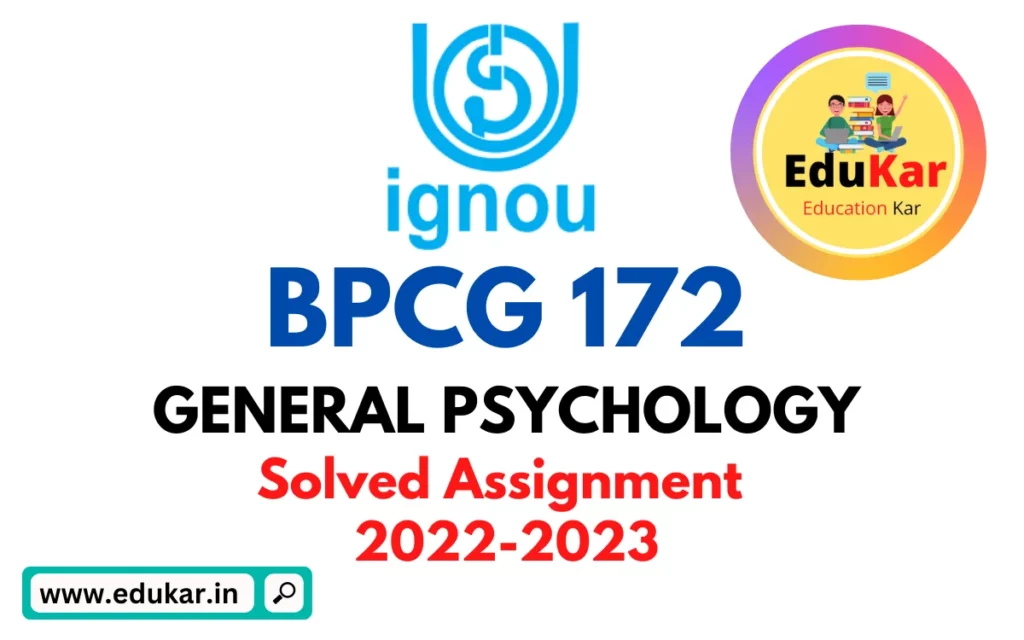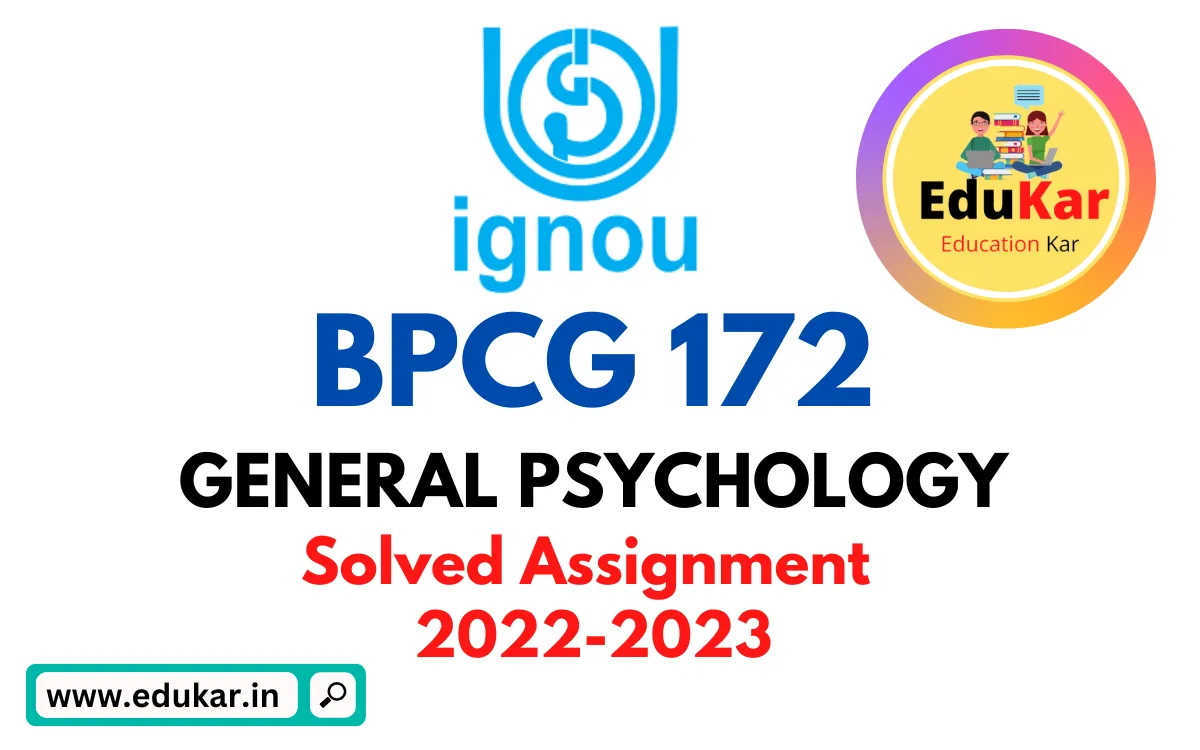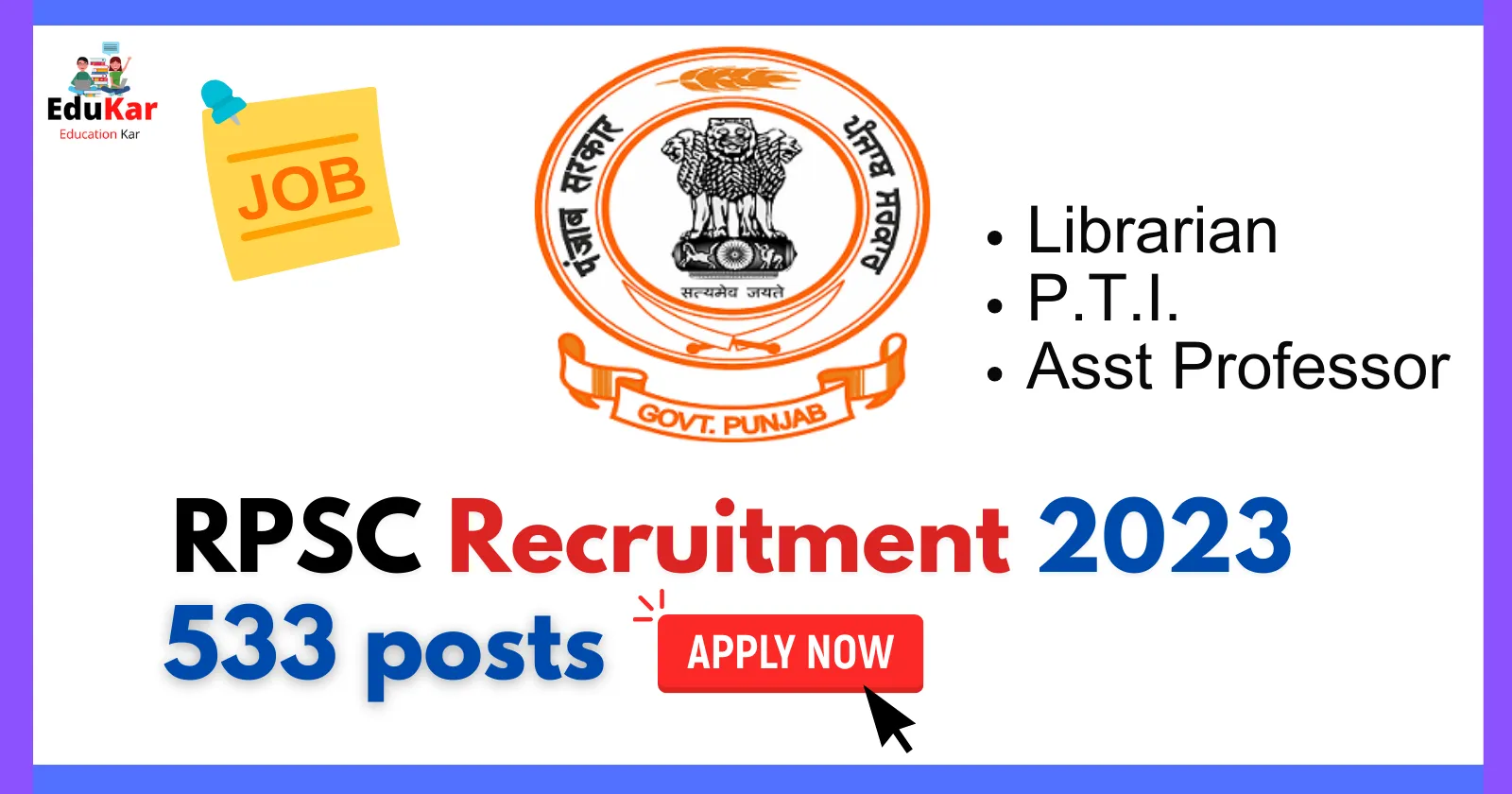Welcome to Edukar.in! This blog provides comprehensive solutions to the questions in the BPCG 172 course offered by the Indira Gandhi National Open University (IGNOU). Our goal is to help students complete their assignments with ease and deepen their understanding of the course material. The solved assignments are expertly prepared, keeping in mind the latest syllabus and guidelines set by IGNOU. With these resources, students can have confidence in their assignments and take their academic journey one step closer to success.

| Title | IGNOU-BPCG 172 Solved Assignment 2022-2023 (YOUTH, GENDER AND IDENTITY) |
| University | IGNOU |
| Degree | Bachelor Degree Programme |
| Course Code | BPCG 172 |
| Course Name | YOUTH, GENDER AND IDENTITY |
| Programme Name | Bachelor of Arts (General) |
| Programme Code | BAG |
| Total Marks | 100 |
| Year | 2022-2023 |
| Language | English |
| Assignment Code | Asst /TMA /2022-23 |
| Last Date for Submission of Assignment: | For June Examination: 31st March For December Examination: 30th September |

Assignment One
Answer the following descriptive category questions in about 500 words each. Each question carries 20 marks.
1. Explain the concept of development. Discuss the cognitive development of youth during the adolescence years.
Ans: Development refers to the systematic and sequential changes that occur in an individual over the course of their life span. It encompasses physical, emotional, social, and cognitive growth, and is influenced by both nature (genetics) and nurture (environmental factors).
Adolescence is a crucial period in development, marked by significant changes in physical, emotional, and cognitive domains. In terms of cognitive development, it is a time of increased capacity for abstract thinking, problem-solving, and decision-making. During this time, individuals develop the ability to think logically and systematically, and they become more adept at considering multiple perspectives and weighing the consequences of their actions.
One of the most important theories of cognitive development during adolescence is that of Swiss psychologist Jean Piaget. According to Piaget, adolescents enter a new stage of cognitive development known as formal operational thought, which is characterized by the ability to think abstractly and logically about complex ideas and situations. This stage is marked by increased abilities in deductive reasoning, hypothesis testing, and the formulation of general principles based on specific experiences.
Another important aspect of cognitive development during adolescence is the development of executive functions. These are higher-level cognitive processes that help individuals plan, prioritize, and organize their thoughts and actions. This is a critical time for the development of these skills, as adolescents are faced with new and complex decision-making scenarios, such as choosing a career path, managing their finances, and navigating social relationships.
Adolescents also undergo significant changes in their brain structure and function, particularly in the prefrontal cortex, which is responsible for executive functions, decision-making, and impulse control. These changes lead to improvements in problem-solving, reasoning, and the ability to consider future consequences.
2. What is work-life balance? Discuss various challenges faced in it.
Ans: Work-life balance refers to the ability of individuals to maintain an appropriate balance between the demands of their work and the demands of their personal life. It involves finding a healthy balance between time devoted to work, leisure activities, and responsibilities at home, and can have a significant impact on overall well-being, health, and happiness.
However, achieving a balance between work and life can be challenging for many individuals, particularly in today’s fast-paced, high-pressure work environment. Some of the most common challenges faced in achieving work-life balance include:
- Long working hours: Long working hours can leave individuals feeling drained and exhausted, making it difficult to find the energy to enjoy leisure activities or devote time to their personal lives.
- Technological connectivity: The advancement of technology has made it easier to work remotely, but it has also made it more difficult to disconnect from work. The constant availability of emails and other forms of electronic communication can blur the boundaries between work and personal life, making it harder to achieve balance.
- Demands of family life: Family life can be demanding, and balancing the needs of children, aging parents, and other family members with work can be challenging.
- Work-related stress: Work-related stress can have a negative impact on individuals’ mental and physical health, and can also make it difficult to devote time to other areas of life.
- Financial pressure: Financial pressure can make it difficult for individuals to prioritize their personal life, as they may feel compelled to work longer hours or take on additional work to make ends meet.
Despite these challenges, there are steps that individuals can take to achieve a better balance between work and life. For example, setting boundaries between work and personal life, taking advantage of flexible work arrangements, practicing stress-management techniques, and prioritizing self-care can all help individuals to find a healthy balance.
Additionally, employers can play a role in supporting work-life balance for their employees. This can include offering flexible work arrangements, providing resources for stress management and self-care, and promoting a culture of work-life balance.
Assignment Two
Answer the following middle category questions in about 250 words each. Each question carries 10 marks.
3. Explain James Marcia’s theory of identity status.
Ans: James Marcia developed a theory of identity status, which describes the four different stages individuals can go through as they search for a sense of self. The four stages include: identity diffusion, identity foreclosure, identity moratorium, and identity achievement.
Identity diffusion is the first stage in which an individual has not yet explored their values, beliefs, or goals. They are generally passive and lack direction in their life.
Identity foreclosure is the second stage, in which individuals have made a commitment to someone else’s values or beliefs, without fully exploring their own. They may have a strong sense of identity, but it may not truly reflect who they are.
Identity moratorium is the third stage, in which individuals are actively exploring their values, beliefs, and goals. They may be in a state of flux, trying out different identities and ideas, but are still searching for a sense of self.
Finally, identity achievement is the fourth stage, in which individuals have a clear and secure sense of who they are. They have explored their values and beliefs and have made a commitment to them.
Marcia’s theory of identity status provides a framework for understanding the different stages of identity development and how individuals can move from one stage to another. It highlights the importance of exploration and self-discovery in the formation of a strong and stable sense of self.
4. Discuss the social bases of identity.
Ans: Identity is a complex and multifaceted concept that is shaped by many different factors. One of the most important of these is the social context in which an individual lives. The social bases of identity refer to the various ways in which individuals are influenced by their relationships with others, the groups they belong to, and the larger social and cultural norms and values that exist in their society.
One of the most significant social bases of identity is family. Family relationships are often one of the first and most important sources of socialization and play a key role in shaping an individual’s values, beliefs, and attitudes. Family members can also provide a sense of belonging, support, and continuity, which are all important for the development of a strong sense of identity.
Another important social base of identity is culture. Culture is the shared norms, values, beliefs, and practices of a particular group of people. It provides a shared context for understanding the world and helps to shape individuals’ perspectives and beliefs about themselves and others. Culture can also play a role in shaping identity through the transmission of beliefs about gender, race, and ethnicity.
Peer groups and social networks are also important social bases of identity. These relationships provide a sense of belonging and support, as well as opportunities for learning and exploration. They can also help to shape an individual’s values, beliefs, and attitudes, especially during adolescence.
Finally, larger social institutions such as schools, religious organizations, and the media can also play a role in shaping identity. They can help to reinforce cultural values and beliefs, as well as provide a sense of social structure and order.
5. Explain the macro influences on educational institutions.
Ans: Macro influences refer to external factors that shape the broader context in which educational institutions operate. These factors have a significant impact on the policies, practices, and outcomes of educational institutions. Some of the key macro influences on educational institutions include:
- Government policies: Governments play a crucial role in the provision of education and the development of education policies. Government policies can influence funding, curriculum, teacher training, and assessment procedures, as well as determine the roles and responsibilities of different stakeholders in education.
- Economic conditions: Economic conditions, such as recession, inflation, and unemployment, can have a significant impact on education. For example, during economic downturns, governments may cut funding for education, which can lead to reduced resources for schools and universities.
- Demographic changes: Changes in demographics, such as population growth, immigration, and aging, can impact education. For example, an increase in immigration may lead to increased demand for language support and special needs services in schools.
- Technological advancements: The rapid pace of technological change has had a profound impact on education. New technologies, such as online learning and educational software, are changing the way that students learn and teachers teach.
- Social and cultural factors: Social and cultural factors, such as changing values and beliefs, can influence education. For example, there may be growing concern about the impact of social media and other forms of digital technology on students and their learning experiences.
Assignment Three
Answer the following short category questions in about 100 words each. Each question carries 6 marks.
6. Media and its impact on youth.
Ans: Media has a profound impact on youth and their development. Through various forms such as television, film, video games, and social media, media can shape young people’s attitudes, beliefs, and behaviors. On the positive side, media can be a source of education and information, help to develop critical thinking skills, and provide opportunities for social connection and creativity. However, on the negative side, media can also expose youth to inappropriate or harmful content, promote unrealistic standards and expectations, and contribute to social isolation and the development of addictive behaviors. It is important for parents and other caregivers to be mindful of the media that young people are consuming and to help them develop the skills and perspectives needed to navigate media in a healthy and responsible way.
7. Drive theories of aggression.
Ans: Drive theories of aggression suggest that aggression is a response to an underlying drive or instinct that motivates an individual to act aggressively. These drives can be triggered by internal or external factors, such as hunger, frustration, or competition. The most well-known drive theory of aggression is the Frustration-Aggression Hypothesis, which states that frustration, or the blocking of an individual’s goals or desires, can lead to aggressive behavior. Another example is the Instinct Theory, which posits that aggression is a innate and biologically determined drive, much like hunger or thirst. These theories have been widely researched and debated, with some researchers providing evidence for the role of drive in aggression, while others argue that the relationship between drive and aggression is more complex and multi-determined. Overall, drive theories provide important insights into the motivations behind aggressive behavior and have helped inform the development of aggression management strategies.
8. Catharsis.
Ans: Catharsis is a concept in psychology and the arts that refers to the release of pent-up emotions or energy through a form of expression, such as art, writing, or physical activity. The theory of catharsis suggests that this release of emotions can provide relief from negative emotions and improve mental and emotional well-being. In the field of psychology, catharsis is often associated with the works of Sigmund Freud and his followers, who believed that the unconscious mind could be purged of negative emotions through the release of repressed feelings. In the field of the arts, catharsis is often used to describe the emotional impact of dramatic works, such as plays and films, that aim to evoke intense emotions in the audience. While catharsis remains a widely discussed and debated concept, it continues to be an important area of study and application in both psychology and the arts.
9. Concept of equity and equality.
Ans: Equity and equality are two concepts that are often used interchangeably but have distinct meanings. Equality refers to treating everyone the same, regardless of their differences. On the other hand, equity refers to providing fairness and justice by considering individual differences and providing what is needed to level the playing field. Equity acknowledges that people have different needs and provides resources and support to overcome any barriers they may face. This approach aims to ensure that everyone has the same opportunity to succeed, regardless of their background or circumstances. Ultimately, the goal is to create a society where everyone has equal access to resources, opportunities, and outcomes.
10. Gender stereotyping.
Ans: Gender stereotyping refers to the oversimplified and rigid beliefs about the characteristics, roles, and behaviors of individuals based on their gender. These stereotypes often lead to biased attitudes and discrimination towards individuals who do not conform to societal expectations of their gender. This can limit individuals’ opportunities and potential in various aspects of their life, including education, employment, and personal relationships. Gender stereotypes also reinforce harmful gender roles, such as women being expected to prioritize care-giving over careers, and men being expected to be emotionless and aggressive. Combating gender stereotypes requires increased awareness and education, as well as a concerted effort to challenge and change societal norms and beliefs about gender. A more inclusive and equitable society can only be achieved by breaking down these harmful gender stereotypes.
How to Download BPCG 172 Solved Assignment 2022-2023 (YOUTH, GENDER AND IDENTITY) Solved Assignment?
You can download it from the www.edukar.in, they have a big database for all the IGNOU solved assignments.
Is the BPCG 172 Solved Assignment 2022-2023 (YOUTH, GENDER AND IDENTITY) Solved Assignment Free?
Yes this is absolutely free to download the solved assignment from www.edukar.in
What is the last submission date for (IGNOU-BAG) Solved Assignment?
For June Examination: 31st March, For December Examination: 30th September







